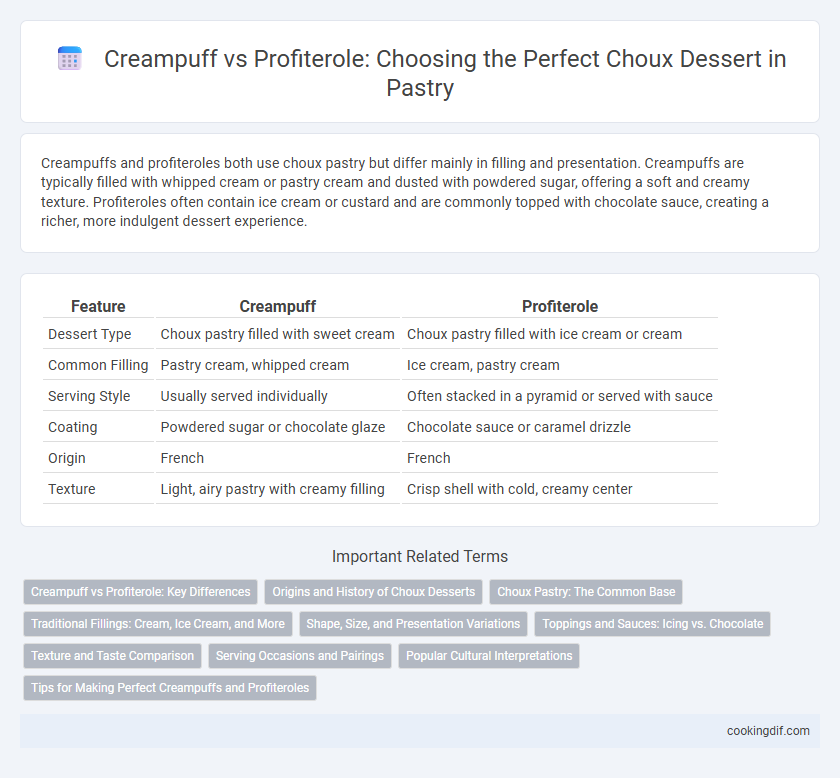Creampuffs and profiteroles both use choux pastry but differ mainly in filling and presentation. Creampuffs are typically filled with whipped cream or pastry cream and dusted with powdered sugar, offering a soft and creamy texture. Profiteroles often contain ice cream or custard and are commonly topped with chocolate sauce, creating a richer, more indulgent dessert experience.
Table of Comparison
| Feature | Creampuff | Profiterole |
|---|---|---|
| Dessert Type | Choux pastry filled with sweet cream | Choux pastry filled with ice cream or cream |
| Common Filling | Pastry cream, whipped cream | Ice cream, pastry cream |
| Serving Style | Usually served individually | Often stacked in a pyramid or served with sauce |
| Coating | Powdered sugar or chocolate glaze | Chocolate sauce or caramel drizzle |
| Origin | French | French |
| Texture | Light, airy pastry with creamy filling | Crisp shell with cold, creamy center |
Creampuff vs Profiterole: Key Differences
Creampuffs feature a light choux pastry filled primarily with sweet whipped cream or custard, whereas profiteroles often contain a variety of fillings including ice cream or savory options. The texture of creampuffs is typically soft and airy, while profiteroles are slightly denser to support their diverse toppings like chocolate sauce or caramel. Size and presentation also differ, with creampuffs usually larger and rounder compared to the smaller, more elaborately garnished profiteroles in classic French cuisine.
Origins and History of Choux Desserts
Choux desserts, including cream puffs and profiteroles, originate from 16th-century France, where choux pastry was first developed by chef Pantarelli to create a light, airy dough. Cream puffs typically refer to choux pastries filled with whipped cream or custard, while profiteroles are often filled with ice cream and topped with chocolate sauce, showcasing the evolution of choux dough in dessert variations. The historical significance of choux pastry lies in its versatility and enduring popularity in French patisserie, influencing countless modern desserts worldwide.
Choux Pastry: The Common Base
Creampuffs and profiteroles both originate from choux pastry, a light, airy dough made by cooking flour with butter and water before incorporating eggs. Creampuffs typically feature a round shape filled with sweet cream or custard, while profiteroles are often smaller, filled with ice cream or sweet fillings and topped with chocolate sauce. The versatile nature of choux pastry allows both desserts to maintain a crisp exterior and hollow interior, ideal for various sweet or savory fillings.
Traditional Fillings: Cream, Ice Cream, and More
Creampuffs traditionally feature a rich pastry cream filling, while profiteroles are commonly filled with ice cream, creating a contrast between warm choux pastry and cold cream. Both desserts often include whipped cream or custard as classic fillings, enhancing their delicate texture. Chocolate sauce or caramel drizzle frequently complements these fillings, elevating the dessert experience.
Shape, Size, and Presentation Variations
Cream puffs are typically larger, round, and often filled with sweet creams or custards, providing a soft, airy texture with a smooth top, making them ideal for individual servings or plated desserts. Profiteroles are smaller, more uniform in size, and usually served in clusters or stacked presentations, filled with pastry cream or ice cream and frequently topped with chocolate sauce for elegant visual appeal. The shape of cream puffs is more domed and rustic, while profiteroles have a more compact, symmetrical appearance, enhancing their versatility in decorative arrangements and dessert towers.
Toppings and Sauces: Icing vs. Chocolate
Creampuffs are traditionally topped with a dusting of powdered sugar or a light glaze of icing, enhancing their delicate sweetness without overpowering the airy choux pastry. Profiteroles feature a rich chocolate sauce, often dark or semi-sweet, generously drizzled over the pastry, creating a luxurious contrast between the crispy shell and creamy filling. The choice of icing on creampuffs emphasizes simplicity and elegance, while the chocolate sauce on profiteroles highlights indulgence and richness in choux desserts.
Texture and Taste Comparison
Creampuffs feature a light, airy choux pastry shell with a smooth, creamy filling that delivers a rich, sweet flavor and a melt-in-the-mouth texture. Profiteroles offer a slightly denser choux shell often filled with ice cream or custard, combining a crisp exterior with a cold, contrasting creamy interior for a balanced taste experience. Both desserts highlight the versatility of choux pastry but differ in texture intensity and the interplay between warm pastry and filling temperature.
Serving Occasions and Pairings
Creampuffs, often filled with sweet vanilla or chocolate pastry cream, are best served at casual gatherings and afternoon teas, pairing excellently with coffee or light fruit wines. Profiteroles, typically filled with ice cream and topped with warm chocolate sauce, make an elegant dessert choice for formal dinners and special celebrations, complementing dessert wines like Sauternes or Moscato. Both choux pastries offer versatile serving options but differ distinctly in their traditional pairings and presentation styles.
Popular Cultural Interpretations
Creampuffs and profiteroles both originate from classic French choux pastry but differ in cultural contexts and fillings, leading to distinct popular interpretations. Creampuffs, often filled with sweet whipped cream or custard, are widely associated with American dessert culture, symbolizing a simple, nostalgic treat at fairs and bakeries. Profiteroles, typically filled with ice cream and topped with chocolate sauce, hold a more sophisticated European identity, frequently served as an elegant dessert in French cuisine and haute patisserie.
Tips for Making Perfect Creampuffs and Profiteroles
Use cold eggs gradually when preparing pate a choux to achieve the perfect airy texture essential for both creampuffs and profiteroles. Pipe consistent-sized rounds onto a baking sheet to ensure even baking and uniform puffing, preventing undercooked centers. Freeze shaped dough before baking to help maintain the structure and create crisp, hollow shells ideal for filling with whipped cream, pastry cream, or ice cream.
Creampuff vs Profiterole for choux desserts Infographic

 cookingdif.com
cookingdif.com